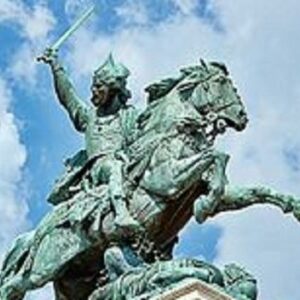Vercingetorix was an Arverni leader who united the Gallic tribes, declared himself king, and led a revolt against Roman forces during Julius Caesar’s Gallic Wars. However, he was able to inspire the oppressed people’s desire for liberation, eventually assembling a massive army made up of all the Gallic tribes. He made his army vigilant to ensure his supporters’ unwavering commitment to his goal. He also imposed heavy punishments to scare his people. At Gergovia, he crippled Julius Caesar’s Roman legion. By the time he rebelled, Caesar had already seized much of the territory by exploiting Gallic tribal factionalism. Vercingetorix fought bravely in the Battle of Alesia, but eventually surrendered to rescue his followers. Five years later, he was killed after a march through Rome.
Early Childhood of Vercingetorix
Vercingetorix was born approximately 82 BC into the Arverni tribe, one of Gaul’s most powerful Celtic clans. On multiple instances, they fought back against the Roman invasion commanded by Julius Caesar.
He was the son of Celtillus the Avernian, a powerful Gallic leader. However, his own people executed his father for pursuing sovereign sovereignty.
The Gallic Revolt
Julius Caesar was appointed governor of Gallia Narbonensis (modern Provence) in 58 BC and set out to subjugate the Gallic nations. He managed the Gallic factions by providing selective political support, as well as luxury items like wine, for a few years.
Most anti-Roman resistance, like Ambiorix’s in 54 BC, had only local support. But Vercingetorix managed to rally the Gallic tribes against Caesar.
Forcibly removing all Roman merchants from Cenabum on February 13, 53 BC, they assassinated one of Caesar’s commissariat officers. The elites, including Vercingetorix’s uncle Gobanitio, thought that such a revolution would only be harmful to the tribe and exiled him and his companions from Gergovia.
Instead of giving up, he rallied the desperate tribesmen to fight for independence and formed a large army. He quickly assaulted Gergovia, drove out the nobles, and became king.
He sent out ambassadors in all directions, hoping to form alliances and inspire others to join his cause. Gradually, the Senones, Parisii, Pictones, Cadurci, Turones, Aulerci, Lemovice, and other tribes along the coast accepted him as their leader.
He demanded a certain number of men from each tribe as soon as he took command of the states. He also set timetables for preparing cavalry and regulating the quantity of armaments each state had to prepare at home.
He quickly assembled a large force and marched north to use natural defenses. He was one of the first commanders to use the scorched earth strategy, destroying cities to deny the Roman army supplies.
The Bituriges’ capital, Avaricum (now Bourges), strenuously objected to the destruction of its natural and man-made defenses. So he spared the town and camped outside its walls, harassing the oncoming Roman army led by Caesar and his main lieutenant Titus Labienus.
After 25 days of agonizing effort, the Romans finally captured the capital, slaughtering all but 800 of the town’s 40,000 inhabitants. The Roman army marched on Gergovia, the Arverni capital, but Vercingetorix and his soldiers crushed Caesar’s legions and allies.
But both sides lost heavily in the next cavalry fight. He then marched his army to the fortress of Alesia.
During the ‘Battle of Alesia’ in September 52 BC, Caesar followed him back to the city and constructed a wall around it. The doughnut-
shaped fortress Caesar built around the city prevented his few Gallic allies from reaching Vercingetorix, the tactical leader.
Initial French attacks failed, but exposed a weak point in the defences, which combined forces from inside and outside were able to almost breach.
However, Caesar personally led his army’s remaining reserves into battle, securing a decisive Roman victory.
Vercingetorix rode his beautiful decorated horse to the Roman camp, stripped off his armor, and surrendered at Caesar’s feet. He was then imprisoned in Rome’s Tullianum and executed five years later, in 46 BC, after being presented in Caesar’s triumph.
Grandiose of Vercingetorix
Vercingetorix is best remembered for rallying the Gallic tribes against the Roman invasion. He also updated the local armed forces.
Memorials of Vercingetorix
The Vercingétorix monument, built in 1865 on the alleged site of Alesia, inspired French nationalism among his subjects. In addition to the statue, Eugène Viollet-le-Duc designed the memorial structure.
The statue by Frédéric Bartholdi on Place de Jaude in Clermont-Ferrand is one of the few in France from the 19th century.
Vercingetorix was also an influence for the popular comic book series ‘Asterix’. ‘Asterix and the Chieftain’s Shield’ and ‘Asterix the Gaul’ are significant appearances that portray his surrender more favorably.
He is a playable commander in Total War: Arena and an opponent in games like Praetorians and Age of Empires.
“Vercingétorix” (Druids) is a 2001 French film that chronicles his life from boyhood to the “Battle of Alesia” Norman Spinrad, co-writer of the film, wrote ‘The Druid King’ in 2003.
Estimated Net Worth
The stimated net worth of Vercingetorix is unknown.
Trivia
A strong warrior king, Vercingetorix derives from the Gaulish elements ver- (superior), cingeto- (warrior), and rix (king). Notably, Plutarch refers to the chieftain as Vergentorix in his Life of Caesar.


